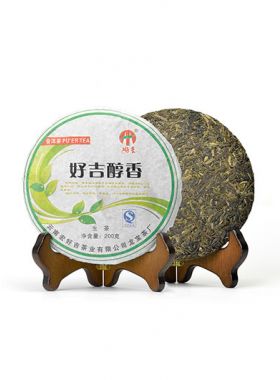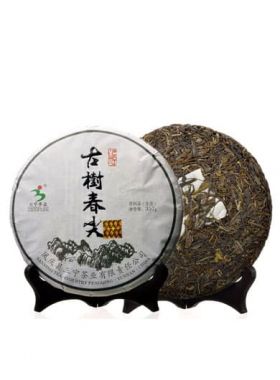-
Fast ShippingFree shipping for orders above $40
to most countries. -
Secure PaymentPay with Paypal, Credit Card …
-
Carefully SelectedFrequently Visit Tea Gardens.
Taste Repetitiously -
15 Days RefundNo Questions Asked
Refund Policy
Fengqing Old Tree Raw Pu-erh Cake Tea 2013
Rock sugar sweet taste, fruity
Rock sugar sweet taste, fruity
| Origin: |
Fengqing County, Lincang City, Yunnan Province, China |
|---|---|
| Harvest Date: |
April 10 - 28, 2013 |
|
Production Date: |
May 18, 2013 |
| Net Weight: |
400g |
| Dry Leaf: |
Round and smooth cake, well-compressed, clear and complete strip, fat tea buds and full of pekoes |
| Aroma: |
Aged flavor, woody aroma |
| Liquor: |
Golden yellow, crystal clear and bright |
| Taste: |
Smooth, soft and thick body comes with obvious rock sugar sweet taste |
| Tea Bush: |
Fengqing large-leaf Tea Tree (300 to 800 years) |
| Tea Garden: |
Xintang Tea Area |
| Caffeine: |
Moderate caffeine (less than 20% of a cup of coffee) |
| Storage: |
Store in cool, dry place away from sunlight; keep ventilated |
| Shelf Life: |
The aged the better |
Angel's Comment:
This Puerh Cake Tea is good for Raw Puerh Tea lovers who prefer tougher and stronger raw puerh taste.
Old Tree pu-erh tea, also commonly called Lao Shu pu-erh, is made using tea leaves from Fengqing large-leaf tea trees between 300 and 800 years old. The ‘old tree’ in the name refers to the wild ancient trees left to grow in natural forests, semi-cultivated old trees in wild areas, or artificially-cultivated trees that have been maintained for at least a century.
Pu-erh tea made from old tree leaves is generally higher in quality than younger teas. Old tea trees are naturally grown in non-polluted environments, resulting in higher nutritional value of the leaves, and it also endures better through more infusions.
For making this tea, the leaves are pan-fried, rolled, dried, and then pressed into loose pu-erh (also known as Saiqing raw tea), after which they are steamed, shaped, and sun-dried again, which results in the end product of the cake.
Different from the new-made Pu-erh tea that has strong and bitter taste, the raw Pu-erh tea will be aged slowly with time. The taste will change and the bitterness will fade, and then it will add many new notes. After 6 years of aging, now the texture of this cake is steady and the bitterness has faded. The thickness is enhanced, and the tea is full and soft when the entrance. Besides, it can be brewed for many steeps and the tea tastes sweeter at the last steeps. This sweetness is similar to crystal sugar and with long lasting in palate.
 |
Cup Method |
 |
Chinese Gongfu Method |
 |
Teacup: 12oz / 355ml |  |
Gaiwan: 3.8oz / 110ml |
 |
203℉ / 95℃ |  |
203℉ / 95℃ |
 |
5g Tea |  |
8g Tea |
 |
Brewing time: 3 - 5 mins |  |
12 steeps: rinse, 10s, 15s, 15s, 20s, 25s, 35s, 50s, 70s, 140s, 180s, 240s, 280s |
| Rinse time is around 5 seconds |
This cake comes from one of the famous wild old tree reserves in Xintang village, Lushi Town, Fenqing. After the trees were planted, the ancient farmers only clipped and harvested them sparsely, and used no fertilizers or pesticides; since then the trees have been left to grow freely.
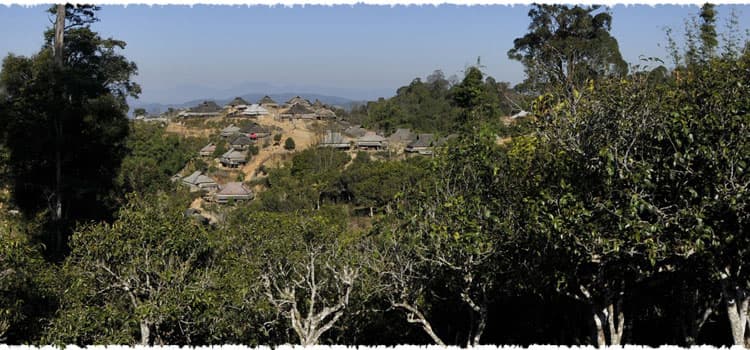
This pu-erh tea is produced in Fengqing, located south of Dianxi Longitudinal Valley. Fengqing is a country in the northwest of Lincang, one of the four famous pu-erh production areas (along with Xishuangbanna, Pu’er, and Baoshan), and is one of the original birthplaces of tea in the world. It is also famous for being the hometown of Yunnan black tea. Fengqing has a long history of planting, producing, and drinking tea, and contains a beautiful throng of mountains webbed with rivers.
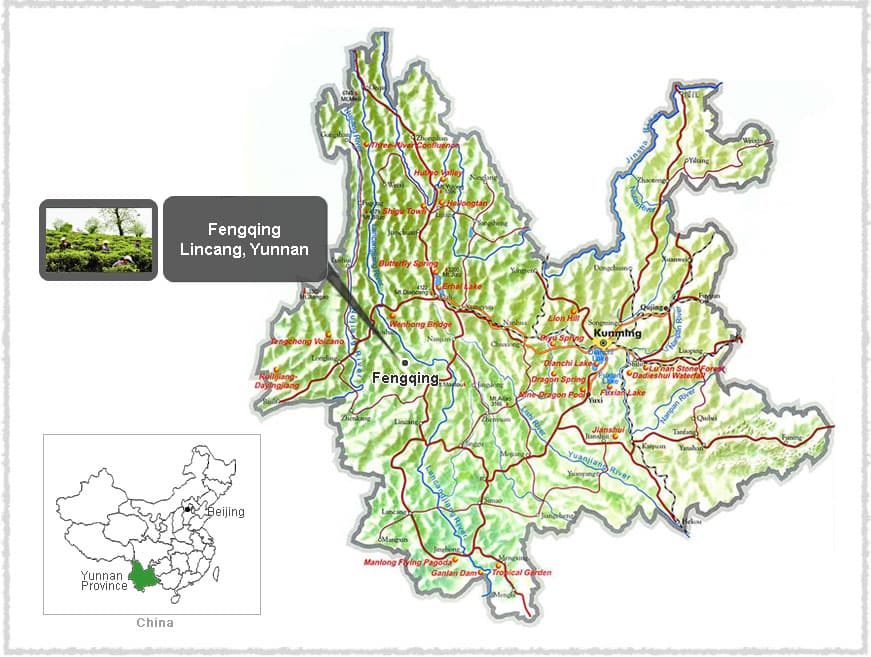
This pu-erh tea is made from the Fengqing large-leaf subspecies of the Yunnan large-leaf. It propagates sexually and takes the form of an arbour tree, meaning that it can grow to over six meters tall. 1984, the Fengqing large-leaf species was certified by the Chinese government as a national grade. It contains an abundance of tea polyphenols (30.2%) and catechins (13.4%), as well as 2.9% amino acids and 3.2% caffeine.
The leaves used to make this cake in particular were carefully selected from 300-500 year old large-leaf tea trees, grown naturally and organically without any artificial fertilizer or pesticide usage, and using only manual farming and caretaking techniques.
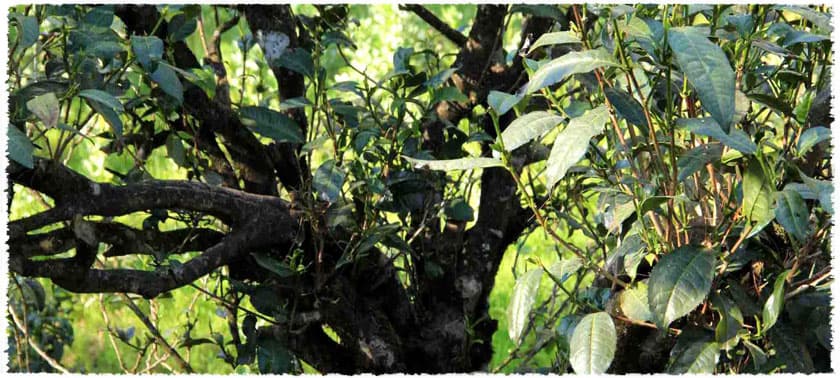
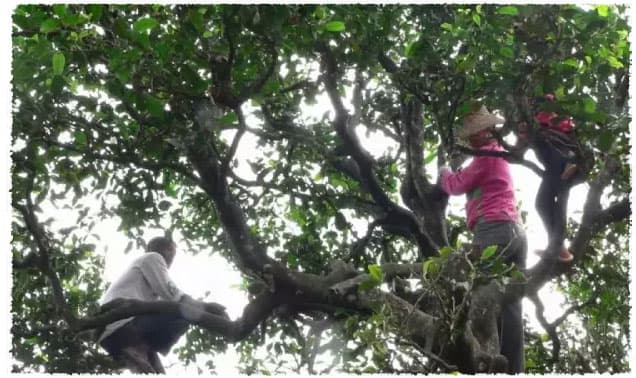
Pu-erh tea is one of the oldest types of Chinese tea, with a history stretching back over 1,700 years to the Eastern Han Dynasty, when the tea was called Jing Cha. It is named after the town of Pu’er in Yunnan province, which was the earliest trading center for this tea. In its early history pu-erh was used as a bartering currency throughout southwest China, and there the famed Cha Ma Gu Dao - or Tea Horse Road - was built especially to transport this tea through the Himalayas to other countries and areas in Tibet.
-
5 stars33
-
4 stars21
-
3 stars5
-
2 stars1
-
1 star1




